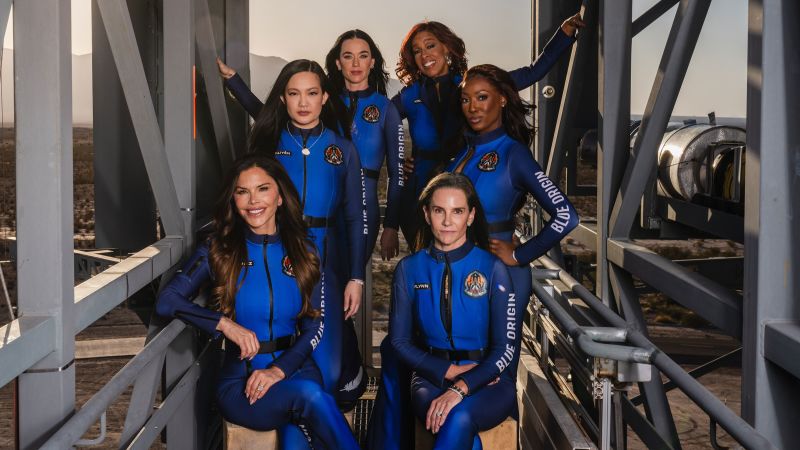Exploring the qualifications and experiences of astronauts is a fascinating topic, particularly as space tourism gains prominence. Recently, Blue Origin launched a meticulously planned suborbital flight that aims to take a select group of six female passengers, including well-known personalities such as singer Katy Perry and journalist Gayle King, to the very edge of space. This anticipated mission, which will last around 10 minutes, plans to ascend over 100 kilometers (62 miles) above Earth, granting passengers a few moments of weightlessness before descending back to their starting point.
The opaqueness surrounding what constitutes “space” is at the forefront of discussions both in the media and amongst space enthusiasts. While the passengers will certainly experience a dramatic view of our planet juxtaposed against the vast emptiness of space, the entities within the spaceflight community remain divided on the specific threshold that separates space from the atmosphere. The crux of the matter rests on various interpretations of altitude and atmospheric phenomena. When do we cross into space? Is the threshold defined by the fading blue glow of our atmosphere, a certain altitude at which satellites can orbit, or an altitude where the atmosphere no longer exerts significant influence on flight dynamics?
The ambiguities regarding when space begins contribute to spirited debates, especially among competitors in the burgeoning commercial space industry. Blue Origin and its rival, Virgin Galactic, often find themselves at odds over the criteria defining space travel, particularly concerning the Kármán line, a renowned and contentious marker situated at approximately 100 kilometers (62 miles) above sea level. Blue Origin’s New Shepard flights technically surpass this benchmark, while Virgin Galactic’s flights typically reach around 88.5 kilometers (55 miles), falling short of the Kármán line yet exceeding the 81-kilometer (50-mile) threshold that the U.S. government has historically used to designate space.
Despite this rivalry, Blue Origin has asserted that its missions grant passengers a more legitimate “astronaut” status, as they’ve intentionally emphasized their adherence to the Kármán line in social media posts, which indirectly critiques Virgin Galactic’s altitude achievements. This competitive atmosphere extends to the definition of what it means to be an astronaut. Traditionally, the U.S. government has awarded astronaut distinctions to military and NASA pilots who ascend beyond 81 kilometers. However, the Federal Aviation Administration shifted its approach in 2021, moving away from issuing physical badges, favoring documentation instead.
Adding further complexity, numerous organizations and agencies contribute to the nebulous definition of an astronaut. For instance, SpaceX issues silver wings to private individuals who have flown aboard its Crew Dragon capsule. The distinction of astronaut is, therefore, at the mercy of recordkeepers and governing bodies, leading to multiform understandings of the term. Former NASA astronaut Terry Virts echoed this sentiment, suggesting that those who successfully launch themselves into space deserve recognition regardless of altitude or the nature of their flight experience.
When we envision astronauts, our minds often conjure images of individuals experiencing the thrill of weightlessness against a backdrop of the cosmos. However, weightlessness can be experienced even at lower altitude flights, as is the case with Blue Origin and Virgin Galactic. Gravitational influences persist even during these brief weightless moments, and passengers will experience a sensation more akin to that of a roller coaster at its peak rather than genuinely floating in a non-gravitational environment like within the International Space Station.
Understanding space and defining altitude become even more complex when considering the multitude of opinions within the scientific community. Some experts believe that a more accurate altitude for distinguishing space lies around 88 kilometers (55 miles) based on the behavior of reentering rocket bodies. The Kármán line itself is subject to fluctuations due to atmospheric density, which has led to debates over exact definitions. While organizations like the Fédération Aéronautique Internationale have long recognized 100 kilometers as the Kármán line, others have proposed varying altitudes based on ongoing research and structural behavior concerning spacecraft.
In the ongoing evolution of space tourism and exploration, definitions may shift and change, reflecting technological advancements and shifts in human perception of space. These discussions illuminate not only the technical aspects of flight but also the social and cultural underpinnings of what it means to engage in activities beyond our terrestrial boundaries. As more individuals pursue suborbital flights, the criteria for astronaut designation may likewise transform to accommodate new standards and expectations, ensuring that the dream of flying among the stars becomes increasingly accessible to the masses.












